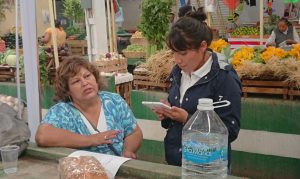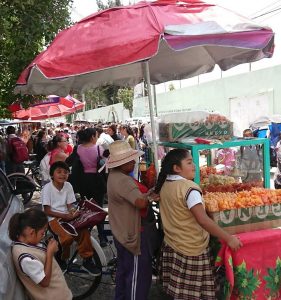Five lessons from nutrition research in lower-income communities of Mexico City
Last summer, I coordinated a project with the aim of assessing the willingness to pay for healthy packaged bread, in lower-income communities of the Mexico City area. In this blog, along with sharing the main results of our first research output, I will mainly describe qualitative findings and personal opinions that came out of this investigation.
In a randomized study, we gathered data from nearly a thousand people in locations close to schools and marketplaces, central squares and a local mall. We found that willingness to pay for high-fiber bread was considerable among low-income groups, but higher among higher-income groups within these communities. Moreover, provided nutrition information was effective only for those with strong preferences for packaged bread. The latter is a novel finding for a non-staple food in a developing country.
Photo credit: Miriam E. Perez Luna
On top of the above findings, below I lay out five lessons that emerged during this research.
#1 Lower-income consumers are knowledgeable about health aspects.
We posited that nutrition information was not effective for all consumers, because they had a comprehensive idea about healthy bread features. These consumers are able to identify quality aspects, that such products are brown/yellowish and have grain decorations perceptible to the eye and taste. Furthermore, most of the participants remembered the nutrition information provided, which to certain extent goes against poverty-related behavioral inattention theories.
#2 They are eager to consume new healthy varieties.
One assumption before going to the field was that most of consumers liked unhealthy white packaged bread. Nonetheless, we shed light on a new trend where particularly younger people have developed certain level of disgust for such product. Participants frequently argued that those breads “stick to the teeth”. Anecdotical evidence also showed that young consumers are even willing to save money to buy healthier packaged bread, at least every other week.
#3 Traditional diets need to prevail.
We studied healthy packaged bread preferences considering new evidence of a gradual transition from maize tortilla to products like bread. From my perspective, that does not mean that we should promote the latter rather than the former. A deviation from the Mexican traditional diet is one of the underlying causes of the obesity pandemic in the country. Maize is one of the main foods in that diet. In line with FAO recommendations, a Mexican-rooted food guide may hold more promise in leading to positive health outcomes.
Photo credit: Miriam E. Perez Luna
#4 Lower-income neighborhoods are research-friendly.
Safety was one of the main components in the data collection sites selection. Regardless of the context, during two months of fieldwork I did not experienced actual unsafety issues. I often found kind and supportive people that enabled the research to take place. Public transport use was eye-opening for me, where daily practice is greeting everyone upon entering and exiting the transport units. I do not disregard external claims, but strongly believe that sometimes perceptions are polarized.
#5 Processors-supermarkets partnership potential.
A business strategy unaddressed by us is making available affordable healthy breads, through food processors and supermarkets alliances. The latter already offers very cheap own brand packaged breads, which are tougher and drier than other commercial options. Such features affected the sensory evaluations and willingness to pay of one of the breads used in our investigation. Thus, own brand breads may be enhanced with processors experience or supply.
All in all, I am satisfied with the fieldwork experience in the selected locations. The above aspects reshaped my perception about doing research and the people in lower-income communities. I am interested in finding out similar encouraging stories in other latitudes of the world.
Note: The research outlined above was jointly designed with International Maize and Wheat Improvement Center (CIMMYT) and was supported by the CGIAR Research Program on Agriculture for Nutrition and Health (A4NH) and the CGIAR Research Program on Wheat (WHEAT). Funding for A4NH and WHEAT comes from CGIAR System donors and others, including national governments, foundations, development banks and other public and private agencies. I am also thankful for the doctoral fellowship (217111) granted by the National Council of Science and Technology (CONACYT).




Excellent Job!!!
Proud of you
Thanks so much, Otoniel!
great work, nicely done.
Thanks, Fan!!
Thanks for sharing your experiences, un my personal experience low income communities have a closer relationship with traditional Mexican culinary arts, having a large proportion of raw and unprocessed ingredients (on the healthy side nowadays).
You are welcome, Fernando! I agree with you, we actually have a lot to copy from these communities, especially the traditional diets that we are deviating from.
Nice insights from field work! Good learning about the small margins for improving healthy diets for poor people.
Thanks, Ruerd! Indeed, great learning experience.